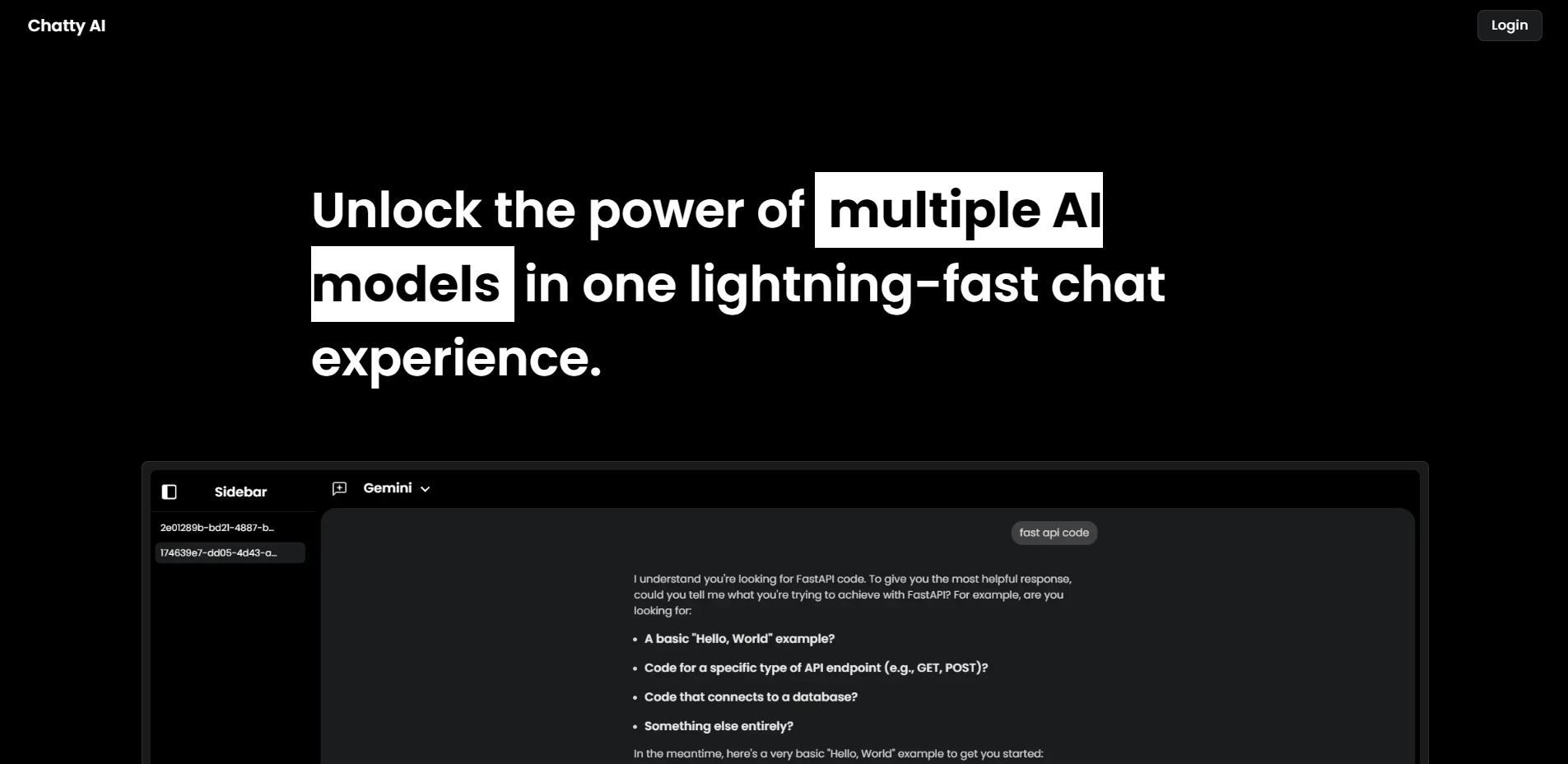Ever wondered what it’s like to chat with AI that actually feels smart? Not just a chatbot that spits out responses, but one that truly converses with you?
Say hello to Chatty-AI—your next favorite tool for exploring the power of modern, AI-driven conversations.
Whether you’re building your own AI assistant, experimenting with multiple models, or just love tinkering with cutting-edge tech, Chatty-AI makes it insanely easy (and fun) to dive in.
🚀 What Is Chatty-AI?
Chatty-AI is a sleek, fast, and highly interactive chat application that brings together multiple AI models under one roof. It’s built with a modern tech stack—Next.js, TypeScript, and Supabase—giving it top-notch performance, real-time capabilities, and room to scale as big as your imagination.
But more than that, it’s a playground for developers, AI enthusiasts, and creators who want to build something cool.
⚡ Why Chatty-AI Stands Out
Here’s what makes it different:
- Multi-AI Model Support – Easily integrate and switch between different AI models to test, compare, or customize conversations.
- Super Smooth UI/UX – Built with performance in mind, the interface is clean, responsive, and snappy across all devices.
- Real-Time Backend – Thanks to Supabase, every message syncs instantly, making interactions feel seamless and alive.
- Developer-Friendly Stack – If you love working with Next.js and TypeScript, you’ll feel right at home.
🧩 What You’ll Learn in This Post
Ready to build your own version of Chatty-AI? Here’s what we’ll cover:
- 🔍 A breakdown of Chatty-AI’s core features
- 🛠 How to set it up and get it running locally
- 🧱 A walkthrough of the project structure so you can customize it your way
Whether you’re looking to create your own smart assistant, prototype a chatbot product, or simply explore the potential of AI-powered UIs, Chatty-AI is the perfect starting point.
👇 Let’s Get Started
In the next sections, we’ll dive into the code, setup instructions, and how you can make Chatty-AI your own. Trust us—it’s easier (and more fun) than you think.
🚀 Key Features
1. Blazing-Fast Performance with Next.js
We’ve built Chatty-AI using Next.js, which offers Server-Side Rendering (SSR) and Static Site Generation (SSG) for optimal performance. This means your chat experience will load quickly, no matter how large the user base or how many messages you send.
2. TypeScript Integration
To ensure a type-safe and maintainable codebase, Chatty-AI uses TypeScript. TypeScript adds a layer of safety by catching type errors during development, making it easier to scale the application in the future.
3. Responsive Design
With Chatty-AI, you can enjoy a smooth and consistent experience on any device. The responsive design ensures that the app works seamlessly across desktop, tablet, and mobile platforms.
4. AI-Powered Conversations
The core of Chatty-AI lies in its ability to generate AI-powered conversations. Using Vercel AI-SDK and the Gemini API, this project brings intelligent, dynamic, and context-aware conversations to life.
5. Modern Tech Stack
Chatty-AI integrates modern technologies that enhance performance and scalability:
- Custom Fonts powered by @next/font/google for a personalized look.
- Rich Icons from Lucide Icons and React Icons to make the UI more engaging.
- State Management with Zustand, providing a simple and scalable state management solution.
- Database Management with Supabase for real-time data syncing and authentication.
📂 Project Structure
The Chatty-AI project is organized into a modular and scalable structure, making it easy to navigate and extend:
- app/: The main application directory, containing the overall app logic and UI components.
- components/: Reusable UI components that handle rendering and user interaction.
- public/: Static assets like images, fonts, and icons.
- types/: TypeScript type definitions to ensure type safety across the app.
- utils/: Utility functions for interacting with Supabase and other services.
- lib/: Custom hooks and helper functions for managing app behavior.
🛠️ Installation Guide
Getting Chatty-AI up and running locally is easy! Follow these simple steps to set up the project:
- Clone the repository:
git clone https://github.com/jackwaghan/Chatty-AI.git - Navigate to the project directory:
cd Chatty-AI - Install dependencies:
bun install - Set up environment variables:
- Add your Resend API Key to the
.env.localfile.
- Add your Resend API Key to the
- Run the development server:
bun run dev - Visit the local server:
- Open your browser and navigate to http://localhost:3000 to see Chatty-AI in action.
🌐 Live Demo
Want to see Chatty-AI in action? Check out the live demo here to explore how AI-powered conversations work in real time!
🤝 Contributing
Open-source projects thrive on contributions, and Chatty-AI is no exception! If you’re interested in enhancing the project, here’s how you can contribute:
- Fork the repository.
- Create a feature branch:
git checkout -b feature/AmazingFeature - Commit your changes:
git commit -m 'Add some AmazingFeature' - Push to the branch:
git push origin feature/AmazingFeature - Open a Pull Request to merge your feature into the main project.
📜 License
Chatty-AI is distributed under the MIT License. You can freely use, modify, and contribute to the project. For more details, refer to the LICENSE file.
🎯 Why Use Chatty-AI?
Chatty-AI is perfect for developers who want to integrate AI models into their chat applications. Whether you’re looking to experiment with AI-driven conversations or build an intelligent chatbot, Chatty-AI offers the perfect foundation. Thanks to its modern tech stack, fast performance, and integration with powerful AI models, Chatty-AI delivers a highly interactive and seamless chat experience.
Experience the power of AI-driven conversations today with Chatty-AI. Whether you’re a developer eager to explore AI integrations or a user searching for a smarter chat app, Chatty-AI has something for everyone!
Let me know if you’d like any further changes or additions! 😊
